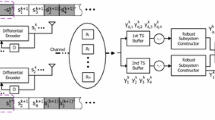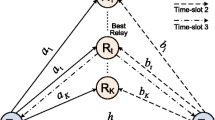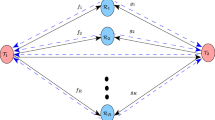Abstract
By introducing orthogonal space-time coding (STC) scheme in wireless cooperative relay network, two distributed differential STC (DSTC) schemes based on the amplify-and-forward (AF) and decode-and- forward (DF) methods are, respectively, developed. The scheme performance is investigated in symmetric and asymmetric wireless relay networks. The presented schemes require no channel information at both relay terminals and destination terminal, and have linear decoding complexity when compared with the existing scheme. Moreover, they are suitable for the application of different constellation modulations and DSTC schemes, and thus provide more freedoms of design. Besides, the power allocations between source and relay terminals are jointly optimized to minimize the system pairwise error probability for symmetric and asymmetric networks, and two practical methods are presented to solve the complicated optimized problem from asymmetric network. Simulation results show that the scheme with DF method has better performance than that with AF method due to no amplification of noise power, but the performance superiority will decrease at high SNR due to the error propagation of decoding at the relays. Furthermore, the distributed DSTC schemes with optimal power allocation have better performance than those with conventional fixed power allocation.






Similar content being viewed by others
References
Chu, S., Wang, X., & Yang, Y. (2013). Exploiting cooperative relay for high performance communications in MIMO ad hoc networks. IEEE Transactions on Computers, 62, 716–729.
Jing, J., & Hassibi, B. (2006). Distributed space-time coding in wireless networks. IEEE Transactions on Wireless Communications, 12, 3524–3536.
Sugiura, S., Xin, N. S., Kong, L., Chen, S., & Hanzo, L. (2012). Quasi-synchronous cooperative networks: A practical cooperative transmission protocol. IEEE Vehicular Technology Magazine, 7, 66–76.
Laneman, J. N., & Wornell, G. W. (2003). Distributed space-time-coded protocols for exploiting cooperative diversity in wireless network. IEEE Transactions on Information Theory, 49, 2415–2425.
Zhao, Q., & Li, H. (2007). Differential modulatin for cooperative wireless systems. IEEE Transactions on Signal Processing, 55, 2273–2283.
Wang, G., Zhang, Y., & Amin, M. (2006). Differential distributed space-time modulation for cooperative networks. IEEE Transactions on Wireless Communicaitons, 5, 3097–3108.
Tarasak, P., Minn, H., & Bhargava, V. K. (2005). Differential modulation for two-user cooperative diversity systems. IEEE Journal on Selected Area in Communications, 23, 1891–1900.
Bansal, A., Bhatnagar, M. R., & Hjørungnes, A. (2013). Decoding and performance bound of demodulate-and-forward based distributed Alamouti STBC. IEEE Transactions on Wireless Communications, 12, 702–713.
Chen, D., & Laneman, J. N. (2006). Modulation and demodulation for cooperative diversity in wireless systems. IEEE Transactions on Wireless Communications, 5, 1785–1794.
Ma, S., & Zhang, J.-K. (2011). Noncoherent diagonal distributed space-time block codes for amplify-and-forward half-duplex cooperative relay channels. IEEE Transactions on Vehicular Technology, 60, 2400–2405.
Himsoon, T., Su, W., & Liu, K. J. R. (2005). Differential transmission for amplify-and-forward cooperative communications. IEEE Signal Processing Letters, 12, 597–600.
Yiu, S., Schober, R., & Lampe, L. (2005). Differential distributed space-time block coding. In Proceeding IEEE PACRIM’05 (pp. 53–56). Victoria, BC.
Zhang, Y. (2005). Differential modulation schemes for decode-and-forward cooperative diversity. In Proceeding IEEE ICASSP’05 (pp. 917–920). Philadelphia, PA.
Maham, B., & Lahouti, F. (2006). Cooperative communication using distributed differential space-time codes. In Proceeding International Conference on Wireless Communications, Networking and Mobile Computing 06 (pp. 1–5). China.
Kiran, T., & Rajan, B. S. (2007). Partially-coherent distributed space-time codes scheme with differential encoder and decoder. IEEE Journal on Selected Area in Communications., 25, 426–433.
Cho, W., & Yang, L. (2006). Distributed differential schemes for cooperative wireless Networks. In Proceeding IEEE ICASSP’06 (pp. 61–64). Toulouse.
Ganesan, G., & Stoica, P. (2002). Differential modulation using space-time block codes. IEEE Signal Processing Letter, 9, 57–60.
Huo, Q., Song, L., Li, Y., & Jiao, B. (2012). A distributed differential space-time coding scheme with analog network coding in two-way relay networks. IEEE Transactions on Signal Processing, 60, 4998–5004.
Tarokh, V., & Jafarkhani, H. (2000). A differential detection scheme for transmit diversity. IEEE Journal on Selected Area in Communications, 18, 1169–1174.
Hughes, B. L. (2000). Differential space-time modulation. IEEE Transactions on Information Theory, 46, 2567–2578.
Tarokh, V., Seshadri, N., & Calderbank, A. R. (1998). Space-time codes for high data rate wireless communication: Performance criterion and code construction. IEEE Transactions on Information Theory, 44, 744–765.
Fan, S. (1989). A new extracting formula and a new distinguishing means on the one variable cubic equation. Natural Science Journal of Hainan Teachers College, 2, 91–98. (in Chinese).
Zheng, L., & Tse, D. (2003). Diversity and multiplexing: A fundamental tradeoff in multiple-antenna channels. IEEE Transactions on Information Theory, 49, 1073–1096.
Acknowledgements
The authors would like to thank two anonymous reviewers for their valuable comments which considerably improved the paper. This work is supported by Fundamental Research Funds for the Central Universities of NUAA (NJ20150014), Research Found of Nanjing Institute of Technology (281240626216068), and National Natural Science Foundation of China (61271255).
Author information
Authors and Affiliations
Corresponding author
Appendices
Appendix 1
In this appendix, we will give the derivation of the optimized objective function in (19). For analysis simplicity, we consider two-relay cases (the extension to multi-relay cases will be straightforward).
By using the related results from [2] and [21], and averaging the above (18) on \(\mathbf{x}_{i-1}\), the following inequality will be obtained.
where \(\mathbf{F}=\hbox {diag}\{|\beta _{i1}|^{2},|\beta _{i2}|^{2}\},\,\mathbf{B}=\mathbf{G}^{H}{} \mathbf{PS}_{i-1}^H \mathbf{C}^{H}{} \mathbf{CS}_{i-1} \mathbf{PG}\). Since \(\mathbf{B}=\mathbf{B}^{H}\), B is a Hermitian matrix. Let \(\lambda _{v} (v=1,2)\) be the two eigenvalues of matrix B, then det \((\mathbf{B})=\lambda _{1}\lambda _{2}\) .Thus according to the analysis of [21], there exists an unitary matrix W such that \(\mathbf{WBW}^{H}=\hbox {diag}\{\lambda _{1}, \lambda _{2}\}\). Moreover, \(\lambda _{1}\) and \(\lambda _{2}\) are nonnegative real values due to the fact that B is also a nonnegative-definite Hermitian matrix. Based on the analysis above, we will have:
where \(\mathbf{Q}=\mathbf{WFW}^{H}=[q_{11}\, q_{12};\,q_{21} \, q_{22}]\). Let \(\mathbf{w}_{1}=[w_{11},\,w_{21}]^{T}\) and \(\mathbf{w}_{2}=[w_{12},\,w_{22}]^{T}\) be two column vectors of W, then \(q_{11}=|\beta _{i1}|^{2}|w_{11}|^{2}+|\beta _{i2}|^{2}|w_{12}|^{2}>0\), and \(q_{22}=|\beta _{i1}|^{2}|w_{21}|^{2}+|\beta _{i2}|^{2}|w_{22}|^{2}>0\). Considering that \(\lambda _{1},\,\lambda _{2}\) and \(E_{s}/(4\kappa N_{0})\) are nonnegative, (47) can be changed to
Substituting (48) into (46), the PEP is rewritten as
According to the definition of the diversity gain [24], using (49), we can evaluate the diversity gain \(G_{d}\) as follows:
Hence, the system achieves full diversity order of 2 for two-relay case. Similarly, we can use the above analytical method to derive the diversity gain of the system with multiple relays. Namely, full diversity order of K will be obtained.
Besides, from (49), it is found that the PEP will be minimized when \(\lambda _{1}\lambda _{2}/\kappa ^{2}\) (i.e. \(\hbox {det}(\mathbf{B})/\kappa ^{2})\) is maximized. According to the definition of matrix G and B, we have:
where \(\zeta =\rho _{s1}^2 \rho _{s2}^2 \rho _{1d}^2 \rho _{2d}^2 \), and \(\mathbf{S}_{i-1}^{H}{} \mathbf{S}_{i-1}=\mathbf{I}_{2}\) is utilized. Since \(\zeta \) and \(\hbox {det}(\mathbf{C}^{H}{} \mathbf{C})\) are independent of the power optimization, we only need to optimize \(\mu _1 \mu _2 P_0^2 P_1 P_2 /\kappa ^{2}\). Based on this, subject to the total power constraint, we may establish the optimized objective function shown as (19).
Appendix 2
In this appendix, we give the derivation of (29). With (28), setting \(\partial \mathcal{L}/\partial P_v =0\,(v=0,1,2)\) yields
Using Eqs. (52a) and (52b), we have:
With equations (52b) and (52c), we can further obtain:
According to the power constraint condition \(2P_{0}+P_{1}+P_{2}=P_{t}\), \(P_{2}\) is rewritten as
Substituting (55) into (54) gives
Substituting (55) and (56) into (53) yields:
Considering that \(P_{0},\,\rho _{s1}\), \(\rho _{s2}\), and \(N_{0}\) are positive, the first factor \((P_0 \rho _{s1}^2 +2N_0)\) and the second factor \((P_0 \rho _{s2}^2 +2N_0)\) as well as the third factor \((P_0 \rho _{s2}^2 +P_t \rho _{2d}^2 -2P_0 \rho _{2d}^2 +2N_0)\) are all not equal to zero, otherwise \(P_{1}\) will become zero in terms of Eq. (56). Hence, (57) can be further simplified as (29).
Appendix 3
In this appendix, we will give the derivation of (31) and proof of the Shengjin’s Formula 4.
By means of variable transformation \(x=t-b/(3a)\), the general cubic equation \({ ax}^{3}+{ bx}^{2}+{ cx}+d=0\) can be changed as
where \(p=({ 3ac-b}^{2})/(3a^{2}),\,q=(2b^{3}-9{ abc}+27a^{2}d)/(27a^{3})\), and \(\Delta \) is given by (30). For \(\Delta <0\), there exist three distinct real roots for cubic equation, so Eq. (58) will have three real roots accordingly. Based on this, we may employ the trigonometric method in [23] to obtain the three roots for Eq. (58). i.e.,
Substituting \(p=({ 3ac-b}^{2})/(3a^{2})\) and \(q=(2b^{3}-9{ abc}+27a^{2}d)/(27a^{3})\) into (59) gives
Considering \(T=(2{ Ab}-3{ aB})/(2A^{3/2})\), \(A=b^{2}-3{ ac}\), and \(B={ bc}-9{ ad}\), we have:
Substituting (61) and \(A=b^{2}-3{ ac}\) as well as \(x=t-b/(3a)\) into (60) yields final three roots:
where \(\theta =\hbox {arccos}T\). This is the Shengjin’s Formula 4.
With (62), considering the constrain condition of \(P_{0}\), \(P_{0}\) can be expressed as (31).
Rights and permissions
About this article
Cite this article
Xu, W., Wang, Q. & Lin, M. Distributed space-time coding scheme with differential detection and power allocation for cooperative relay network. Telecommun Syst 66, 431–445 (2017). https://doi.org/10.1007/s11235-017-0297-0
Published:
Issue Date:
DOI: https://doi.org/10.1007/s11235-017-0297-0




